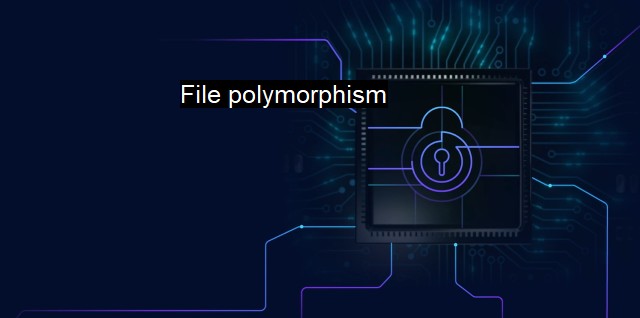What is File polymorphism?
Uncovering File Polymorphism: The Next Chapter in Cybersecurity Threats And Prevention Techniques
File polymorphism refers to a sophisticated technique used by malware creators and cybercriminals to evade detection from antivirus software. The concept emerged from the evolution in malware strategies aimed at advancing its persistence and intrusion capacities. Today, file polymorphism is one of the most potent threats that can compromise and disrupt digital systems, primarily because its mutating properties render traditional antivirus defenses ineffective.File polymorphism involves a malware modifying its code to create a multifarious and distinct version of itself while preserving the core functions. This self-altering characteristic allows malware to constantly change its signature while running on a system, producing numerous different forms (hence polymorphism) to evade detection. The same file can appear in multiple shapes or forms without affecting the original exploit or payload, hence the term 'polymorphic'.
Antivirus software typically compares scanned files to threat signatures or examines behavioral patterns to identify potential malicious entities. file polymorphisms make this task challenging, considering they can alter file characteristics such as their names, types, sizes, and other metadata. This dynamism enables the file to blend into the environment and deceive signature-based detection methods. A polymorphic file changes every time it replicates, thereby presenting a new signature on each iteration and making it nearly impossible for traditional virus scanners that rely on static signatures to detect it.
There are two main classes of polymorphic malware: encrypted and non-encrypted.
Encrypted polymorphic malware is complex in that part of the virus - the decryption module, remains static, whereas the encrypted part, containing the potential tip-off infection pattern, continually changes. the decryption code at the start remains constant while the rest dynamically changes using a different encryption key for each copy.
Non-encrypted polymorphic malware alternatively alters the actual program code to evade detection. This subclass of file polymorphism involves varying not only the encryption key but also the algorithm itself by introducing nondestructive transformations. Code permutations, register renaming, trash code insertion, or equivalent instruction substitution are some ways to achieve non-encrypted polymorphic malware.
Malware researchers have developed advanced methods like artificial intelligence (AI) and machine learning (ML) to combat file polymorphism more effectively. Static Analysis uses AI techniques to predict the functionalities of file polymorphisms, while Dynamic Analysis runs the malware in a safe environment, such as a sandbox, to observe its behavior.
File polymorphism represents a defining challenge to modern-day cybersecurity. While technological advancements provide foresight and protection, the aspect of the constant evolution of these threats prevails. Such resilience underlines the need for continuous cybersecurity vigilance and advancements, especially considering the exponential increase in data usage global industries are experiencing.
Understanding the concept of file polymorphism helps underline the importance of robust and adaptable cybersecurity solutions. These should be capable not only of detecting and responding to known threats but also of preemptively identifying potential polymorph threats. A multi-layered approach, incorporating regularly updated antivirus, intrusion detection, behavior analysis, and machine learning technologies can provide an effective defense against the persistent and morphing threats posed by file polymorphism.
The landscape of cybersecurity threats frequently evolves, presenting new and sophisticated challenges for industries and individuals. File polymorphism, with its ability to continually mutate while sustaining its malicious functionalities, represents a significant hurdle to conventional cybersecurity measures. anticipation, awareness, understanding, and the use of advanced algorithms and methodologies are critical tools in tackling this persistent threat.

File polymorphism FAQs
What is file polymorphism in cybersecurity?
File polymorphism refers to a technique used by malware to change its code or signature to evade detection by antivirus software. It allows the malware to appear different each time it infects a new system, making it difficult for antivirus programs to detect and remove it.How does file polymorphism work?
File polymorphism works by using encryption or obfuscation techniques to alter the code of the malware. This changes the signature of the malware, making it harder for antivirus software to recognize it. Once it infects a system, the malware can use the same technique to change its code again, making it even more difficult to detect.How can antivirus software detect file polymorphism?
Antivirus software uses a variety of techniques to detect file polymorphism, including signature-based detection, heuristic analysis, and behavior-based detection. Signature-based detection involves looking for known patterns or signatures of malware, while heuristic analysis looks for suspicious behavior patterns. Behavior-based detection involves monitoring the behavior of programs to detect unusual or malicious activity.What can individuals do to protect themselves from file polymorphism malware?
To protect themselves from file polymorphism malware, individuals should keep their antivirus software up to date and use additional security measures such as firewalls and intrusion detection systems. They should also be cautious about opening email attachments, downloading files from the internet, and clicking on links from unknown sources.| | A | | | B | | | C | | | D | | | E | | | F | | | G | | | H | | | I | | | J | | | K | | | L | | | M | |
| | N | | | O | | | P | | | Q | | | R | | | S | | | T | | | U | | | V | | | W | | | X | | | Y | | | Z | |
| | 1 | | | 2 | | | 3 | | | 4 | | | 7 | | | 8 | | |||||||